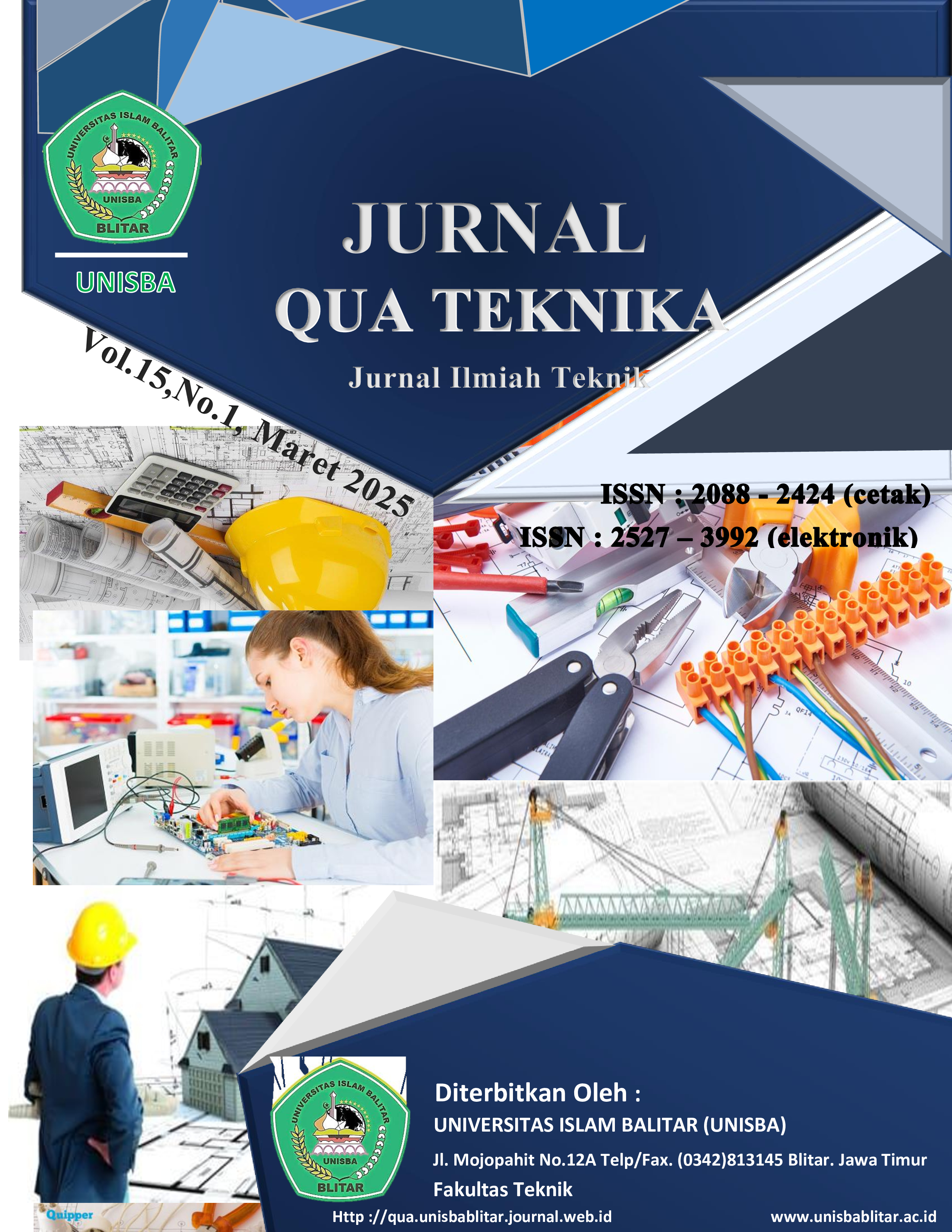THE INFLUENCE OF NON-STANDARD ELECTRICAL INSTALLATIONS ON THE RISK OF HOUSE FIRES IN PARE SUB-DISTRICT, KEDIRI REGENCY
DOI:
https://doi.org/10.35457/quateknika.v15i01.4357Keywords:
home electrical installations, fire risk, standardization.Abstract
The Pare sub-district had the highest fire incidence rate in Kediri Regency in 2023, with 20% of fire incidents being house fires, and 37.5% of these caused by electrical installations that did not meet the required standards. The community lacks awareness regarding the use of standard electrical installations. This study employed a qualitative approach, using interviews and observations, and analyzed the data through source and method triangulation to ensure the validity of the findings. The results indicated that all houses of respondents who had experienced fires had non-standard electrical installations. The components of the electrical installation, such as cables, junction boxes, and switches, exhibited a high level of non-compliance, with cables being the most problematic component (100% non-compliant), followed by junction boxes (80%) and switches (60%). Cables were the primary contributor to fire incidents, accounting for 80% of cases. Junction boxes and light fittings also contributed to the fires in the respondents' houses, with each accounting for 10%.
References
[2] A. D. Prok, H. Tumaliang, and M. Pakiding, “Penataan Dan Pengembangan Instalasi Listrik Fakultas Teknik UNSRAT 2017,” J. Tek. Elektro dan Komput., vol. 7, no. 3, pp. 207–218, 2018, [Online]. Available: https://ejournal.unsrat.ac.id/index.php/elekdankom/article/view/20767
[3] S. Siripto, “Teknik Instalasi Listrik,” Univ. Muhammadiyah Yogyakarta, pp. 1–86, 2017.
[4] Undang- Undang RI No. 30, “Undang - Undang Republik Indonesia Nomor 30 Tahun 2009 Tentang Ketenagalistrikan,” Pres. Republik Indones., vol. 2009, no. 75, pp. 31–47, 2009.
[5] Peraturan Pemerintah RI No. 14, “Peraturan Pemerintah Republik Indonesia Nomor 14 Tahun 2012 Tentang Kegiatan Usaha Penyediaan Tenaga Listrik,” Pres. Republik Indones., vol. 66, pp. 37–39, 2012.
[6] B. Pascalisa and I. Junaida, Kabupaten Kediri dalam Angka 2023. Kediri: BPS Kabupaten Kediri, 2023.
[7] et. al. Sena Wahyu Purwanza, METODOLOGI PENELITIAN KUANTITATIF, KUALITATIF DAN KOMBINASI. Bandung: CV. MEDIA SAINS INDONESIA, 2022. [Online]. Available: https://books.google.co.id/books?id=0CjKEAAAQBAJ
[8] A. Kusumastuti, A. M. Khoiron, and F. Annisya, Metode penelitian kualitatif. Lembaga Pendidikan Sukarno Pressindo (LPSP), 2019. [Online]. Available: https://books.google.co.id/books?id=637LEAAAQBAJ
[9] J. W. Creswell, RESEARCH DESIGN: Pendekatan Kualitatif, Kuantitatif, dan Mixed. Yogyakarta: Pustaka pelajar, 2012.
[10] L. A. Abdillah et al., Metode Penelitian dan Analisis Data Comprehensive. in 1. Cirebon: Penerbit Insania, 2021. [Online]. Available: https://books.google.co.id/books?id=dSY5EAAAQBAJ
[11] M. F. Luthfiyah, Metodologi Penelitian: Penelitian Kualitatif, Tindakan Kelas & Studi Kasus. Bima: CV Jejak (Jejak Publisher), 2018. [Online]. Available: https://books.google.co.id/books?id=UVRtDwAAQBAJ
[12] S. P. Sutarno, Cermat Berbahasa Indonesia : Suplemen Materi Bahasa Indonesia, 1st ed. Sukabumi: CV Jejak (Jejak Publisher), 2019. [Online]. Available: https://books.google.co.id/books?id=RFjRDwAAQBAJ
[13] Sugiyono, Metode Penelitian Pendidikan: (Pendekatan Kuantitatif, Kualitatif dan R&D). Bandung: Alfabeta, 2008. [Online]. Available: https://books.google.co.id/books?id=0xmCnQAACAAJ
[14] L. J. Moleong and T. Surjaman, Metodologi Penelitian Kualitatif. Remadja Karya, 1989. [Online]. Available: https://books.google.co.id/books?id=YXsknQEACAAJ
Downloads
Published
Issue
Section
License
Copyright (c) 2025 Jurnal Qua Teknika

This work is licensed under a Creative Commons Attribution-ShareAlike 4.0 International License.
Authors who publish with this journal agree to the following terms:
- Copyright on any article is retained by the author(s).
- Author grant the journal, right of first publication with the work simultaneously licensed under a Creative Commons Attribution License that allows others to share the work with an acknowledgement of the work’s authorship and initial publication in this journal.
- Authors are able to enter into separate, additional contractual arrangements for the non-exclusive distribution of the journal’s published version of the work (e.g., post it to an institutional repository or publish it in a book), with an acknowledgement of its initial publication in this journal.
- Authors are permitted and encouraged to post their work online (e.g., in institutional repositories or on their website) prior to and during the submission process, as it can lead to productive exchanges, as well as earlier and greater citation of published work.
- The article and any associated published material is distributed under the Creative Commons Attribution-ShareAlike 4.0 International License
Deprecated: json_decode(): Passing null to parameter #1 ($json) of type string is deprecated in /home/ejournal.unisbablitar.ac.id/public_html/plugins/generic/citations/CitationsPlugin.php on line 68










